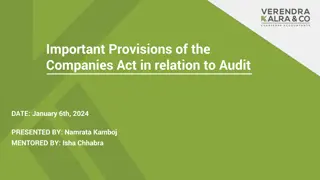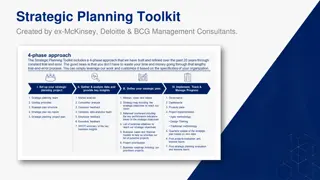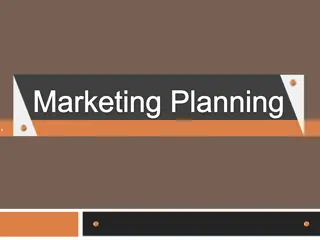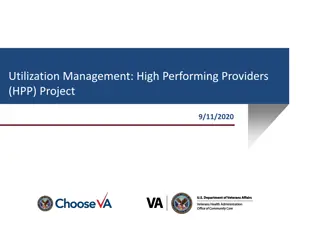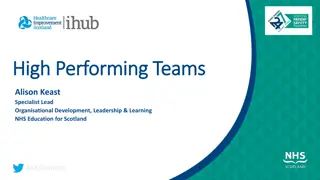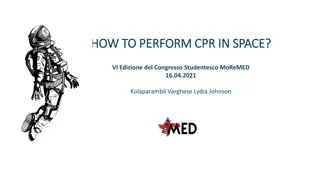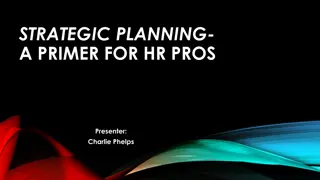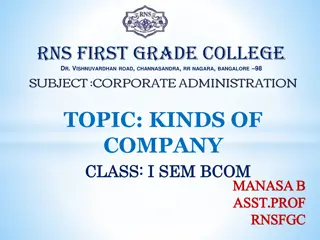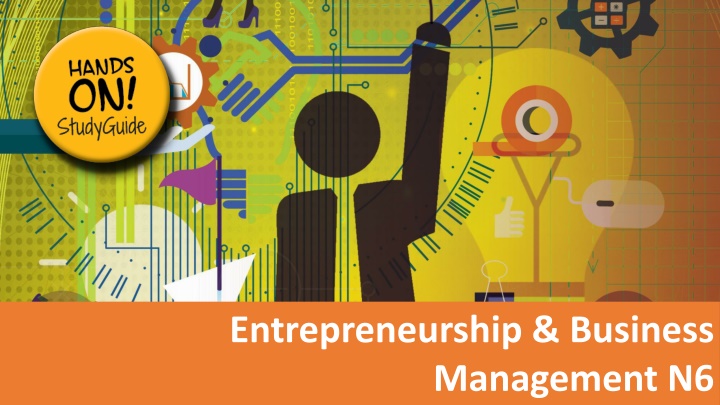
Strategic Planning in High-Performing Companies
High-performing companies exhibit clear direction, skilled entrepreneurship, commitment to strategic action plans, results-oriented management, and active strategy implementation. Learn about decision-making processes, techniques, and the dynamic business environment fostering entrepreneurship and economic development.
Download Presentation

Please find below an Image/Link to download the presentation.
The content on the website is provided AS IS for your information and personal use only. It may not be sold, licensed, or shared on other websites without obtaining consent from the author. If you encounter any issues during the download, it is possible that the publisher has removed the file from their server.
You are allowed to download the files provided on this website for personal or commercial use, subject to the condition that they are used lawfully. All files are the property of their respective owners.
The content on the website is provided AS IS for your information and personal use only. It may not be sold, licensed, or shared on other websites without obtaining consent from the author.
E N D
Presentation Transcript
Entrepreneurship & Business Management N6
Chapter 1: Strategic planning in your business INTRODUCTION There are certain specific characteristics that high-performing companies have which separate them from low-performing companies: There is a clear sense of direction; There is an abundance of skilled entrepreneurship; Managers are committed to having a good strategic action plan; Management is results-orientated and performance conscious; and Managers are strongly involved in implementing the chosen strategy. www.futuremanagers.com
Chapter 1: Strategic planning in your business (continued) DECISION-MAKING PROCESS Management could take these steps in their decision-making process to assist in developing the most effective strategic plan. www.futuremanagers.com
Chapter 1: Strategic planning in your business (continued) DECISION-MAKING TECHNIQUES Various techniques can be used to stimulate creativity and help to develop alternative solutions during the decision-making process. There are a few suggested techniques: www.futuremanagers.com
Chapter 2: Dynamic business environment INTRODUCTION There are more than 1 million small, medium and micro-enterprises in the country, employing almost half of the labour force. These enterprises include: Survivalist enterprises; Micro-enterprises; Small enterprises; and Medium enterprises. www.futuremanagers.com
Chapter 2: Dynamic business environment (continued) THE GROWTH IN ENTREPRENEURSHIP There is a growing awareness that people have to create their own jobs to become economically viable. This has led to a large increase in the creation of various types of small businesses and a strong emphasis on the development of Entrepreneurship. The growth in Entrepreneurship plays a critical role in the economic development of the country. www.futuremanagers.com
Chapter 2: Dynamic business environment (continued) ENTREPRENEURIAL PROFILES There is a large variety of entrepreneurs who have made a success of their specific enterprises. Broad categories of entrepreneurial profiles include: Women entrepreneurs; Family business owners; Part-time entrepreneurs; Copreneurs; and Home-based Intrapreneurs. entrepreneurs; www.futuremanagers.com
Chapter 2: Dynamic business environment (continued) THE POWER OF SMALL BUSINESS Small businesses are vitally important because: They constitute more than 90% of the businesses in South Africa; They create most of the new job opportunities; They take the initiative and create innovative ideas; They serve as a manifestation of the free market system; They are flexible and adaptable; and They provide access to the business world for many people. www.futuremanagers.com
Chapter 2: Dynamic business environment (continued) ENTREPRENEURIAL TRANSITION Any new business, if it is successful, will start to grow. A new business is likely to grow through different stages. www.futuremanagers.com
Chapter 2: Dynamic business environment (continued) CHANGE Organisations are influenced by economic, political, technological, climatic and various other changes. There are reasons for the benefits of change for a business: Competition; Government; Employees; and Environment. www.futuremanagers.com
Chapter 3: Implementation of strategic planning in your business INTRODUCTION A company s mission is the vision a manager has of what his or her business is trying to do and to become in the future. A mission statement indicates the route the company is going to follow in future. www.futuremanagers.com
Chapter 3: Implementation of strategic planning in your business (continued) BUSINESS STRATEGY Strategies guide companies on how to achieve long-term objectives and how to strive towards the company s mission. Strategies indicate how to reach performance targets, how to compete successfully against rivals, and how to obtain a competitive advantage. Implementing a strategy is the beginning of an ongoing process in business management. www.futuremanagers.com
Chapter 3: Implementation of strategic planning in your business (continued) STRATEGY IMPLEMENTATION There are several factors that will influence implementation of strategies: Buy-in from workforce; Sufficient resources; Existing structures, policies and procedures; and Incentives. www.futuremanagers.com
Chapter 4: Competitive analysis INTRODUCTION An industry competitive analysis refers to the external situational analysis of a single-business company. It looks at the macro-environment of the business; analyses the overall position of an industry and then makes decisions whether the industry is an attractive option. www.futuremanagers.com
Chapter 4: Competitive analysis (continued) DOMINANT ECONOMIC CHARACTERISTICS There are certain basic factors to consider when you want to identify the primary economic features of a specific industry, such as the: Size of the market; Number of buyers; Scope of competition; Capital requirements; Market growth rate; Industry probability; and Number of competitors; Rapid technology change. www.futuremanagers.com
Chapter 4: Competitive analysis (continued) DRIVING FORCES There are forces in motion that create incentives or pressures for change. These are the driving forces. They have the biggest influence on the kind of changes that will take place in an industry and its environment. www.futuremanagers.com
Chapter 4: Competitive analysis (continued) COMPETITIVE FORCES Porter s five forces model Porter s five forces model www.futuremanagers.com
Chapter 4: Competitive analysis (continued) KEY SUCCESS FACTORS Key success factors are those things that are critical for a business to succeed. These are: Managing and developing people; Strategic focus; Effective operations; Physical resources; and Customer relations. www.futuremanagers.com
Chapter 5: Strategy and competitive advantage INTRODUCTION A company achieves a competitive advantage when its business strategy succeeds in making its product or service more attractive than those of other companies. www.futuremanagers.com
Chapter 5: Strategy and competitive advantage (continued) GENERIC COMPETITIVE STRATEGIES There are three generic approaches to competitive strategy that stand out: Striving to be the low-cost producer; Differentiation of your product from a rival s products; and Focusing on a narrow portion of the market, rather than going for the whole market. www.futuremanagers.com
Chapter 5: Strategy and competitive advantage (continued) STRATEGIES TO SECURE COMPETITIVE ADVANTAGE The six basic offensive strategies used to gain a competitive advantage are: Attack competitor strengths; Attack competitor weaknesses; Grand offensives; End-run offensives; Guerrilla offensives; Pre-emptive strikes. www.futuremanagers.com
Chapter 5: Strategy and competitive advantage (continued) STRATEGIES TO PROTECT COMPETITIVE ADVANTAGE Defensive strategies can strengthen a company s competitive position. Strategies include: Block competitors offensives; Block competitors offensives; Hide true profitability. www.futuremanagers.com
Chapter 6: Buying an existing business INTRODUCTION When an entrepreneur has decided to start his or her own business, /she can decide to start a business from scratch, buy an existing business or buy into a franchise operation. Many people may go for the option of buying an existing business. www.futuremanagers.com
Chapter 6: Buying an existing business (continued) ADVANTAGES WHEN BUYING AN EXISTING BUSINESS The benefits of buying a business include: It saves time, money and effort to find a location. You take over the existing customers of the business. Sales to existing customers will supply an immediate income. It is possible to buy the business at a bargain price. Relationships with the bank, suppliers, etc. will already be established. The entrepreneur may inherit a trained staff with the business. www.futuremanagers.com
Chapter 6: Buying an existing business (continued) DISADVANTAGES WHEN BUYING AN EXISTING BUSINESS The drawbacks of buying a business include: The location of the business may no longer be convenient for customers. The existing business may have a bad reputation in the community. The existing facilities may need to be repaired or may not work properly. The existing stock may be outdated, poorly selected and slow moving. The price of the business may be too high. www.futuremanagers.com
Chapter 6: Buying an existing business (continued) THE RIGHT WAY TO BUY A BUSINESS There are a variety of things you must consider before buying an existing business. 1. Analyse your own skills and interests; 2. List the potential businesses for sale; 3. Evaluate businesses and select the best one; 4. Explore financing options; and 5. Ensure a smooth transition. www.futuremanagers.com
Chapter 6: Buying an existing business (continued) EVALUATING AN EXISTING BUSINESS There are five critical areas to analyse when evaluating a business: Why the owner wishes to sell; The physical condition of the business; What the potential is for the company s products and services; What legal aspects need to be considered; and The financial position of the business. www.futuremanagers.com
Chapter 6: Buying an existing business (continued) DETERMINING THE VALUE OF A BUSINESS When determining the value of a business, there are two aspects to consider: Firstly one must determine the value of the physical or tangible assets of the business. Secondly, one must determine a value for the goodwill, or intangible assets, of the business. www.futuremanagers.com
Chapter 7: Franchising INTRODUCTION Franchising can be defined as the marketing system which revolves around a mutual agreement whereby one party is granted the privilege of conducting business as an individual business owner but is required to operate according to certain methods and terms specified by the other party. www.futuremanagers.com
Chapter 7: Franchising (continued) FRANCHISING AS BUSINESS OPTION The franchise agreement works as follows: A company which runs a successful business grants another person the right to sell the same goods and services according to its guidelines.The goods and services are already well known in the marketplace and the franchisee can rely on the franchising company for advertising and promotion. www.futuremanagers.com
Chapter 7: Franchising (continued) TYPES OF FRANCHISING There are four basic types of franchising systems: Manufacturer retailer; Manufacturer wholesaler; Wholesaler retailer; and Service/trademark holder retailer. www.futuremanagers.com
Chapter 7: Franchising (continued) ADVANTAGES OF FRANCHISING The benefits of franchising include: Many franchise systems have developed good training programmes. The business will open with a well-established name. The franchisee will need less capital to start up than starting his/her own business from scratch. The franchisee gets the benefits of the franchisor s advertising and promotional efforts on a national and/or regional scale. www.futuremanagers.com
Chapter 7: Franchising (continued) DISADVANTAGES OF FRANCHISING The drawbacks of franchising include: The franchisor will control the quality of the franchisee s business. The franchisee must pay the franchisor for the services provided and for the use of the company name. The franchisee will not be able to sell the franchised business to anybody without the approval of the franchisor Certain policies may affect the profitability of the franchisee. www.futuremanagers.com
Chapter 7: Franchising (continued) GETTING TO KNOW THE FRANCHISE BUSINESS Before getting into a franchise business, get to know details on: The franchisor; The franchise concept; Operational details; Franchise fees; Franchise contract; and Franchise agreement. www.futuremanagers.com
Chapter 7: Franchising (continued) FRANCHISE ASSOCIATION OF SOUTH AFRICA (FASA) FASA is a voluntary body created in order to regulate the franchise industry in South Africa. www.futuremanagers.com
Chapter 8: International Business Plan INTRODUCTION International trade can broadly be defined as the exchange of goods and services between two countries or political entities. The South African Government through its Department of Trade and Industry encourages foreign trade through a variety of initiatives. www.futuremanagers.com
Chapter 8: International Business Plan (continued) THE ROLE OF GOVERNMENT IN INTERNATIONAL TRADE It is in a government s interest to support and encourage trade with other countries. There are several reasons why: It leads to an expansion of the economy; Money comes into the country, which means better balances of payments; It creates employment; New technology and knowledge are imported; Additional taxes are generated through tariffs that are levied on imports. www.futuremanagers.com
Chapter 8: International Business Plan (continued) INTERNATIONAL MARKETING Marketing consists of activities that are aimed at offering products and services to satisfy the needs of customers. International marketing involves the same process but takes place across national boundaries. www.futuremanagers.com
Chapter 8: International Business Plan (continued) THE INTERNATIONAL MARKETING ENVIRONMENT A company needs to do a lot of research specific country before deciding on an export destination. It is important to understand: A country s economic situation; The culture of the country; and Any political and legal issues in the country. www.futuremanagers.com
Chapter 8: International Business Plan (continued) MARKETING INFORMATION It is important for a company to research marketing information regarding a country which might be an export potential. There are three basic sources of information for the exporter: Secondary or published information; Knowledgeable individuals within the market; and Personal investigation. www.futuremanagers.com
Chapter 9: Consultancy INTRODUCTION Consultancies can mean two things to a prospective entrepreneur or small business owner: Firstly, consulting can be a possible business option for the person who has skills and knowledge; Secondly, if a person has started a business already, consultancies can help him to run the business effectively www.futuremanagers.com
Chapter 9: Consultancy (continued) FUNCTIONS OF A CONSULTANT The consultant analyses the problems in the small business. The consultant advises the client on alternative ways to solve a problem. The consultant is a teacher and instructor who uses his knowledge and experience to open up a new field of systems, methods and thoughts for the entrepreneur. The consultant is also an initiator and innovator. He initiates change and renewal in a business to find solutions for specific problems. www.futuremanagers.com
Chapter 9: Consultancy (continued) CONSULTANCY OPPORTUNITIES The four main categories of consultancy types which offer consultancy opportunities are: Personal consultants; Business consultants; Technical consultants; and Executive consultants. www.futuremanagers.com
Chapter 9: Consultancy (continued) MERITS OF CONSULTANCIES There are benefits in consulting: Advantages: Challenging career; The satisfaction of helping others; Varied work assignments; It can be very rewarding financially; You can employ your skills, talents and and abilities to the fullest; Exciting opportunities may open up You don t have to follow an 8-to-5; for the consultant. www.futuremanagers.com
Chapter 9: Consultancy (continued) MERITS OF CONSULTANCIES There are also drawbacks in consulting: Disadvantages: Irregular living conditions on certain Stress in finding clients; and occasions (long work days and days No long-term job security. away from home); Tremendous job stress and pressures in certain situations www.futuremanagers.com
Chapter 9: Consultancy (continued) CONTRACTORS AND SUB-CONTRACTORS A contractor takes responsibility for a specific job and has control over the job contract. The sub-contractor is a person or company who does a specific part or aspect of a job for the main contractor. His contract is therefore with the contractor and not with the final consumer. www.futuremanagers.com
Chapter 10: Overview of a Business Plan MARKETING PLAN There are main components of marketing: Identify the target market; Determine the needs and wants of this market; Develop a suitable product range; Promote and sell the product/service; Distribute the product; and Provide after-sales service. www.futuremanagers.com
Chapter 10: Overview of a Business Plan (continued) FINANCIAL PLAN Performing a financial feasibility study helps determine whether or not a business idea is a good one. Important questions that one should be able to answer are: What are the costs involved in my business and how can I finance them? What is profit, how is it calculated, and will I make a profit? How much are my products actually costing? How much are my competitors charging for the same product? www.futuremanagers.com
Chapter 10: Overview of a Business Plan (continued) FUNDING OPTIONS TO START YOUR BUSINESS A business owner could find funding from: Personal funds; Friends and relatives; Equity shares; and Loans. www.futuremanagers.com

